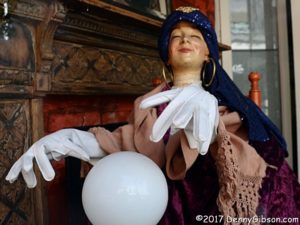 Last Sunday, a website I follow (Cincinnati Refined) posted an article about a free walking tour in nearby Covington, KY. It sounded promising and my interest level climbed a little more when the information was shared to the Dixie Highway Facebook group. The connection came from the fact that the walking tour was on Covington’s Pike Street and Pike Street once carried the Dixie Highway. On Wednesday I took part in the weekly tour. The picture at right was taken at the end of the tour so I’ll cover it at the end of this post.
Last Sunday, a website I follow (Cincinnati Refined) posted an article about a free walking tour in nearby Covington, KY. It sounded promising and my interest level climbed a little more when the information was shared to the Dixie Highway Facebook group. The connection came from the fact that the walking tour was on Covington’s Pike Street and Pike Street once carried the Dixie Highway. On Wednesday I took part in the weekly tour. The picture at right was taken at the end of the tour so I’ll cover it at the end of this post.
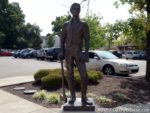
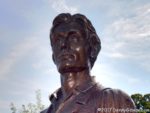 The tour start point was at the Kenton County Library on Scott Street just a short distance north of Pike’s eastern end. The Dixie Highway followed Scott and Pike through the intersection. A life sized Abe Lincoln stands at the entrance to the library’s parking lot. Beardless Lincoln’s aren’t as rare as they used to be or maybe they never were as rare as I thought they were. Few, however, show a Lincoln as young as the Matt Langford sculpture unveiled in 2004. That’s one good looking dude.
The tour start point was at the Kenton County Library on Scott Street just a short distance north of Pike’s eastern end. The Dixie Highway followed Scott and Pike through the intersection. A life sized Abe Lincoln stands at the entrance to the library’s parking lot. Beardless Lincoln’s aren’t as rare as they used to be or maybe they never were as rare as I thought they were. Few, however, show a Lincoln as young as the Matt Langford sculpture unveiled in 2004. That’s one good looking dude.
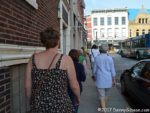
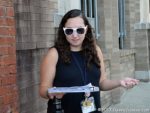 We met inside the library then walked past Abe to where Pike Street Ts into Scott. There our guide Krysta gave us an overview of the tour and some background on Pike Street. The street takes its name from the Covington and Lexington Turnpike that was chartered by the state in 1834. The street really was something of a commercial and transportation center with railroad freight and passenger terminals being built beside it.
We met inside the library then walked past Abe to where Pike Street Ts into Scott. There our guide Krysta gave us an overview of the tour and some background on Pike Street. The street takes its name from the Covington and Lexington Turnpike that was chartered by the state in 1834. The street really was something of a commercial and transportation center with railroad freight and passenger terminals being built beside it.
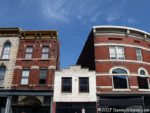
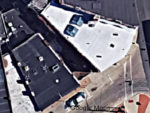 Pike Street jogs south at Madison Avenue then slants off to the southwest. These buildings are in the obtuse angle on the north side of the street. I’ve driven through this intersection countless times and walked through it a few but never thought about how the buildings fit into it until another tour member mentioned it. They are, as the overhead from Google Maps shows, literally wedged in.
Pike Street jogs south at Madison Avenue then slants off to the southwest. These buildings are in the obtuse angle on the north side of the street. I’ve driven through this intersection countless times and walked through it a few but never thought about how the buildings fit into it until another tour member mentioned it. They are, as the overhead from Google Maps shows, literally wedged in.
As we walked west on Pike we stopped frequently as Krysta told us about specific buildings and people associated with them. Two of the buildings in the preceding photo were included. The short white building in the center was most recently the home of Bronko’s Chili. It is currently being renovated for some unknown purpose. The fancy mosaic arch was added to the building next door in 1929. That’s the year that Casse’ Frocks, the name embedded in the arch, opened several stores in what was intended to be a nationwide chain. October’s stock market crash brought the effort to an abrupt end but no one has seen fit to replace the classy facade in all the years since. An identical storefront still stands on Main Street in Cincinnati.
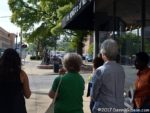 Frank Duveneck was born in Covington and a statue of the famous artist stands in a small triangle park formed by Pike, 7th, and Washington Streets. We didn’t actually enter the park but we learned a lot about Duveneck’s life with the statue in view. We are standing on Washington Street with Pike then 7th crossing in front of us. Back in the day, Washington was something of a dividing line with stores, restaurants, and taverns to the east and grittier enterprises such as livery stables, distilleries, and mortuaries to the west.
Frank Duveneck was born in Covington and a statue of the famous artist stands in a small triangle park formed by Pike, 7th, and Washington Streets. We didn’t actually enter the park but we learned a lot about Duveneck’s life with the statue in view. We are standing on Washington Street with Pike then 7th crossing in front of us. Back in the day, Washington was something of a dividing line with stores, restaurants, and taverns to the east and grittier enterprises such as livery stables, distilleries, and mortuaries to the west.
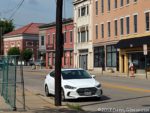 We walked beyond Washington to the middle of the block. The brick building farthest away in the picture is the former passenger terminal. The fence next to us encloses an area where several buildings, including a former distillery where a friend operated a bar back in the 1970s, stood until earlier this summer. Bricks falling from one of the buildings last fall left one person with permanent injuries and sent three others to the hospital temporarily. Safety was a big factor in the decision to demolish the buildings.
We walked beyond Washington to the middle of the block. The brick building farthest away in the picture is the former passenger terminal. The fence next to us encloses an area where several buildings, including a former distillery where a friend operated a bar back in the 1970s, stood until earlier this summer. Bricks falling from one of the buildings last fall left one person with permanent injuries and sent three others to the hospital temporarily. Safety was a big factor in the decision to demolish the buildings.
It was here that the tour officially ended and most people headed back toward the library. I used some of the time on the walk back to raise the subject of the Dixie Highway. Neither the article where I’d learned of the tour nor the library’s online description gave me any reason to expect the Dixie to be mentioned but, as a fan of the old road, I sort of hoped it would be. Krysta’s answer to my query was simply that they had not spent any time learning about the Dixie Highway. That matched what I was seeing. The focus of the tour and of the guides’ ongoing research was the individual buildings along the street. The beginning comments about the turnpike era were pretty much taken from a marker in that park with Duveneck’s statue. The Dixie Highway thing is minor and somewhat esoteric. The tour’s purpose was to inform participants about the buildings and it did that quite nicely.
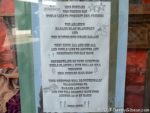
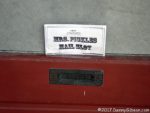
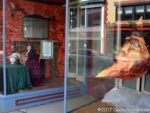 Now for that opening picture. I noticed the moon on the walk west but merely gave it a glance. With a fortune teller in the background and without my attention being directed elsewhere, it hooked me solidly on the way back. Swami! How I love you, how I love you!
Now for that opening picture. I noticed the moon on the walk west but merely gave it a glance. With a fortune teller in the background and without my attention being directed elsewhere, it hooked me solidly on the way back. Swami! How I love you, how I love you!
